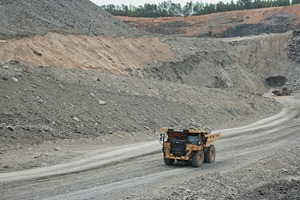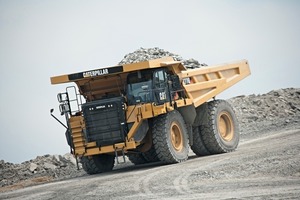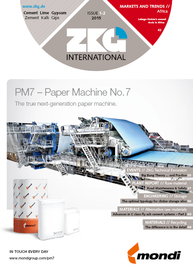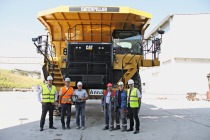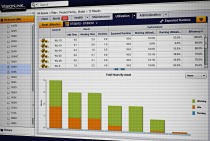Road Maintenance & Safety
The quarry & aggregates industry is one of tough applications that demands durable machines. The equipment used is selected to maximize uptime and productivity at the lowest cost per ton and unscheduled downtime is not acceptable. In addition, maintaining a safe work environment is critical. Inadequate haul roads, walkways or scaffolding, poor housekeeping, lack of training, and operator fatigue can cause accidents and injuries. Putting safety first in quarry operations goes hand in hand with maximizing production and lowering operating costs.
Haul road design
The proper design of haul roads has a significant impact on safety as trucks must be able to travel with their target payload in safe conditions and at the rated speed in all weather conditions during the day and at night (Fig. 1).
Changing weather conditions with rain and snow can be a big challenge, especially for quarry operations in Central and Northern Europe while free access to water can be a real challenge for quarries located in Mediterranean Europe. To ensure continuous as well as safe hauling, a proper haul road design is needed. Generally speaking, a good haul road has crowned straight sections, super-elevated curves, and safety berms with drainage ditches on both sides, and is constructed with well graded sub-base material. Proper lighting in the load and dump areas is essential for night operations.
1. Haul road – Straights
In the majority of European quarries haul roads must support two-way traffic. In order to ensure safe operations during day and night, a minimum of three truck widths is recommended for the straight sections (Fig. 2). For the corners and curves, a minimum of four truck widths is recommended. This allows safe passing of loaded and unloaded trucks without reducing speed. Proper haul road width is critical for operator visibility and to avoid blind spots in curves and at the top of the grade.
In areas where the ideal width is not possible, truck speed must be reduced and speed limit signs clearly posted and rigorously enforced.
Haul roads should be guarded with safety berms. As a rule of thumb, the height of the safety berms should measure at least one-half of the wheel height of the largest truck in the fleet.
Properly designed haul roads are crowned in the straight sections to allow water drainage. Two percent is adequate for most areas. Three percent may be necessary in the higher rainfall regions.
In many quarries, extraction and hauling is conducted in both day-shift and night-shift operations.
The installation of lighting equipment at the key areas of the haul road and at the load and dump areas are critical to enhance visibility, and therefore the safety of the operation.
2. Haul road – Curves
Negotiating curves can generate high lateral tire forces, which contribute to high tire wear and tread separation. Super-elevation—the difference in height between the inside and outside edges of the bed of a banked road—helps control these forces.
When properly designed, super-elevated curves keep the load properly positioned over the tires and truck chassis, decreasing side forces on the tire casing, and reducing scuffing and wear. In addition, super-elevation allows trucks to operate at more consistent and safe speeds. Maintaining a consistent speed allows the truck to maximize fuel efficiency. The amount of super-elevation depends on the curve’s radius and the speed at which it is negotiated.
3. Haul road grades
For haul roads, the correct grade is also of high importance, because it affects where the load sits on the tires and minimizes rock spillage on the haul road. The goal is for thirty three percent of the load to be in the front of the truck and sixty six percent to be in the rear. The ideal grade is between eight and ten percent (Fig. 3).
In addition, constant grades reduce transmission up/down shifting and therefore have a positive impact on the fuel consumption and drivetrain component life.
The haul road begins at the loading face and ends at the dump point which means that the load and dump areas should be smooth and free of rocks and potholes. The proper design of the bench and dump areas can reduce spillages and therefore wear and tear on the tyres whilst at the same time reducing the risk of accidents.
Haul road maintenance
1. Keep the haul roads clean
While the haul road design has a significant effect on safety and tire life, by far the biggest risk of cut and damaged tires is caused by rocks, debris and potholes on the haul road. When a tire comes in contact with a rock, the tread can be cut or the belting of the tire can separate, which reduces the tire’s structural strength. Making sure haul roads are free from rocks and other debris should be a top priority on every quarry site to maximize tire life and improve safety.
Dust control is another major concern. Airborne dust and debris can limit operator visibility and therefore site safety. Sound haul road maintenance requires dedicated equipment and properly trained personnel. A motor grader with a trained operator is essential for cleaning and grading the haul roads. Likewise a water truck with a trained operator is essential for dust control. Maintaining proper grades, rolling resistance and dust control are critical elements of a profitable and safe quarry operation.
2. Highwall hazards
Highwall safety is important for any employee working in the quarry and aggregates industry. It is recommended to conduct hazard recognition highwall safety training in which employees are asked to identify the following during the examination: cracking, rutting, loose ground, sloughage and large rocks causing obstacles. If material needs to be dumped over a berm, this should be done while maintaining the safety height requirements. Safety berm heights should be a minimum of half the wheel height of the largest piece of equipment working on the site. Any changes that occur during a shift on the highwall should be communicated to the following shift personnel. Loose material should also be scaled prior to performing work. Remember to position shovels and trucks so that the cabs swing away from the highwall when loading.
3. Operator training
Operator training is important to every aspect of quarrying operations—especially for safety. Motor grader operators need training in how to properly maintain haul roads to ensure optimum and safe hauling conditions.
Truck operators need to be aware of how their driving habits have an impact on safety, tire life and fuel consumption.
Daily safety & inspection walk-arounds of the truck should be conducted by the operator in order to identify safety issues. The safety checks should incorporate a tire pressure check and visible tire cuts.
4. Traffic flow
Traffic flow creates a potential danger area for daily operators and jobsite visitors. All traffic and directional signs must be in good working condition. Ensure all employees and visitors are trained on safety and the proper traffic flow and that they abide by the rules set forth by the site. For instance, some jobsites have a left-hand traffic pattern which allows better visibility of the ditch line and is safer in wet conditions. Right of way determines which vehicle moves first when two or more pieces of equipment are in the same area at the same time. Right of way should be pre-determined by the site management and communicated to all individuals using the haul roads. In quarry operations, heavy-equipment normally always has the right of way.
5. Machine safety features – Example Cat® 777G
Quarry class off-highway trucks are benefitting from engineering design and upgraded features from the bigger mining class trucks. For example, the Cat Road Analysis Control (RAC) system available for many years in Cat mining trucks is now available at the larger end of the quarry class trucks, such as the 777G.
Quarry trucks can help quarry managers effectively manage haul roads and increase truck life.
With today’s advancements in design and manufacture, off-highway trucks have become so comfortable that operators may not experience sufficient road-feel to detect damaged road conditions that can impact cost and productivity, and reduce truck life as a result of damage to frames, tires, rims, and power train components.
Road Analysis Control (RAC), a haul road management tool, provides feedback to the operator about road conditions, quantifies the severity of the condition, and allows management to make more informed haul road maintenance decisions to reduce overall costs.
Road Analysis Control (RAC) is an on-board information technology tool designed to measure and benchmark haul road quality. Integrated with the Vital Information Management System of the machine, RAC measures component loading and impact shock, communicates that data to the operator, and to the quarry office in real time. For trucks equipped with GPS technology, coordinates can be identified and broadcast to other trucks, support equipment, and maintenance vehicles.
RAC provides data and reports, which enable quarry managers to quantify, monitor and manage haul road severity to increase truck life and reduce cost per ton of material moved.
A badly maintain haul road with bumps and pot holes can significantly reduce component life and therefore increase repair costs.
A well designed and maintained haul road helps avoid accidents, reduce fuel consumption, increase tyre life and allow higher speed and therefore shorter cycle times.


